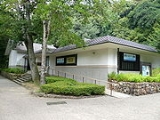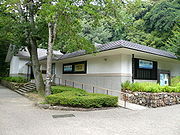
Eizo Kato
Encyclopedia
was a Japan
ese painter
in the nihonga
style. He and his younger brother, Tōichi Katō
, have a museum dedicated to their works in Gifu
, Gifu Prefecture
.
merchant. His early education took place at local schools when he graduated from Gifu Commercial High School in 1923.
In 1926, he entered into the Tokyo Fine Arts School
in Nihonga
Studies, where he would spend the next five years studying art and entering competitions. It was in 1929 that he first submitted a work to the Japan Art Academy
’s 10th annual event, entering a piece entitled “Small Scenes of a Summer Day” (夏日小景 Natsubi Shōkei). In 1931, he graduated from the Tokyo Fine Arts School in Nihonga Studies.

Japan
Japan is an island nation in East Asia. Located in the Pacific Ocean, it lies to the east of the Sea of Japan, China, North Korea, South Korea and Russia, stretching from the Sea of Okhotsk in the north to the East China Sea and Taiwan in the south...
ese painter
Painting
Painting is the practice of applying paint, pigment, color or other medium to a surface . The application of the medium is commonly applied to the base with a brush but other objects can be used. In art, the term painting describes both the act and the result of the action. However, painting is...
in the nihonga
Nihonga
or literally "Japanese-style paintings" is a term used to describe paintings that have been made in accordance with traditional Japanese artistic conventions, techniques and materials...
style. He and his younger brother, Tōichi Katō
Toichi Kato
was a Japanese painter in the nihongo style and board chairman of the Nitten, a significant Japanese art conference. He and his older brother, Eizō Katō, have a museum dedicated to their works in Gifu, Gifu Prefecture.-Biographical summary:...
, have a museum dedicated to their works in Gifu
Gifu, Gifu
is a city located in the south-central portion of Gifu Prefecture, Japan, and serves as the prefectural capital. The city has played an important role in Japan's history because of its location in the middle of the country. During the Sengoku period, various warlords, including Oda Nobunaga, used...
, Gifu Prefecture
Gifu Prefecture
is a prefecture located in the Chūbu region of central Japan. Its capital is the city of Gifu.Located in the center of Japan, it has long played an important part as the crossroads of Japan, connecting the east to the west through such routes as the Nakasendō...
.
Biographical summary
Katō was born in 1906 Gifu's Mizono-chō as the third son of a lacquerwareLacquerware
Lacquerware are objects decoratively covered with lacquer. The lacquer is sometimes inlaid or carved. Lacquerware includes boxes, tableware, buttons and even coffins painted with lacquer in cultures mostly in the Eastern Hemisphere.-History:...
merchant. His early education took place at local schools when he graduated from Gifu Commercial High School in 1923.
In 1926, he entered into the Tokyo Fine Arts School
Tokyo National University of Fine Arts and Music
or is one of the oldest and most prestigious art schools in Japan. Located in Ueno Park, it also has facilities in Toride, Ibaraki, Yokohama, Kanagawa, and Kitasenju, Adachi, Tokyo...
in Nihonga
Nihonga
or literally "Japanese-style paintings" is a term used to describe paintings that have been made in accordance with traditional Japanese artistic conventions, techniques and materials...
Studies, where he would spend the next five years studying art and entering competitions. It was in 1929 that he first submitted a work to the Japan Art Academy
Japan Art Academy
is the highest ranking artistic organization in Japan. The Academy discusses art-related issues, advises the Minister of Education on art-related issues, and promotes art is the highest ranking artistic organization in Japan. The Academy discusses art-related issues, advises the Minister of...
’s 10th annual event, entering a piece entitled “Small Scenes of a Summer Day” (夏日小景 Natsubi Shōkei). In 1931, he graduated from the Tokyo Fine Arts School in Nihonga Studies.
- 1939 His work entitled “Moonlit Night” (月夜 Tsukiyo) was a special selection at the Third Shinbunten.
- 1945 Many of his works were destroyed in the air raidsAirstrikeAn air strike is an attack on a specific objective by military aircraft during an offensive mission. Air strikes are commonly delivered from aircraft such as fighters, bombers, ground attack aircraft, attack helicopters, and others...
of Gifu City on July 9. - 1950 Split from the Nitten Exhibition.
- 1951 Rejoined the Nitten Exhibition.
- 1956 Entered “Basket Fire” (篝火 Kagaribi) into the 12th Annual Japan Arts Exhibition. It is from this time that he started focusing on cormorant fishingCormorant Fishing on the Nagara Riverhas played a vital role in the history of the city of Gifu, Gifu Prefecture, Japan. Throughout its long history, it evolved from a means to live, to a profitable industry, to a major tourist draw...
as his subject, about which he created many pieces. - 1958 At the refounding of the Japan Arts Exhibition, he was named to the exhibition's council.
- 1965 Entered “Thunder God” (雷神 Raijin) in the 8th New Nitten Exhibition.
- 1969 Was named the director of the Japan Arts Exhibition.
- 1972 Died on May 24.
- 1974 The "Eizō Katō Posthumous Exhibitions" were held in Tokyo and Gifu.

- 1991 The Eizō & Tōichi Katō Memorial Art MuseumEizo & Toichi Kato Memorial Art MuseumThe is a museum located in Gifu Park in the city of Gifu, Gifu Prefecture, Japan. It is dedicated to the works of the brothers Eizō and Tōichi Katō, who were born in the city. It is part of the Gifu City Museum of History.-Facility layout:...
was opened in Gifu. - 1992 The "Eizō Katō: 20th Anniversary Exhibition" was opened in Tokyo.

